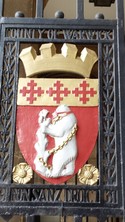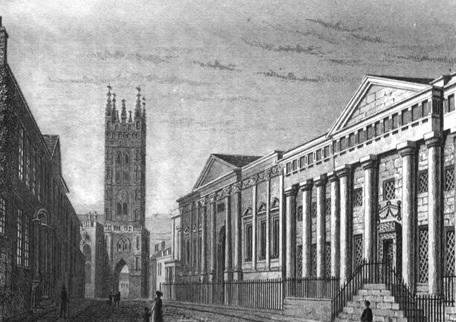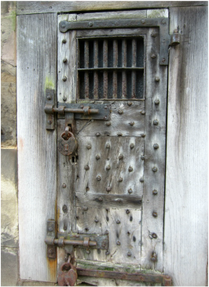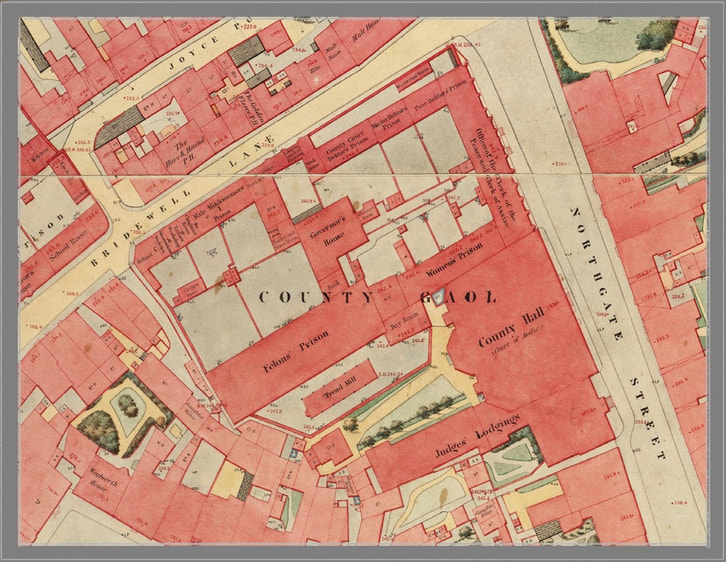WARWICK GAOL
|
Warwick Gaol, also known as the County Gaol, was located to the north of Warwick town centre which lies on the banks of the River Avon . The gaol was surrounded by a strong wall 23 feet high enclosing a space of approximately one acre. The stone frontage on Northgate Street (on the righthand side of the street, furthest from St Mary's Church in the engaving below) had Doric pillars (the plainest of the Greek columns with a square on top) and a set of steps leading into the self-contained public offices of the Clerk of the Peace and other officials.
Next to the gaol stood the County Hall, an imposing building also on the right hand side of Northgate Street, closest to the church, that was completed in 1776. It contained a large, lofty room with galleries and two Courts of Justice including the Warwick County Assizes where John Collins stood trial.
|
The entrance to the actual prison itself was round the corner on Bridewell Lane (later Barrack Street) and consisted four main divisions: Misdemeanors, Debtors, Women's Prison and the Male Felons' Prison (or criminal side) , the latter being where John Collins began his twelve month sentence in August 1839.
|
Cramped Conditions in Warwick Gaol
The prison had 79 tiny, narrow cells, each of which measured approximately 10 yards by 2 yards with 9 foot high arched ceilings, and contained up to three iron beds each with a straw mattress and wooden pillow.
There were no sheets, only a blanket, which together with the mattress had to be rolled up tightly during the day and probably would have been unhygenic and stinking! On at least four occasions Collins shared a bed with other prisoners, including a rapist and two men convicted of assault. Beds were no more than 3 feet 6 inches wide. |
|
No Escape From Warwick Gaol!
Each cell had two doors, an inner of wood and an outer of iron grating. Since there was no window in Collins' cell the only light came through a grating.
As to the floors, these were made of brick. Prisoners were not allowed to wear their shoes - thus impeding any possible escape! And of course there was no form of heat. In Case of Misbehaviour
There was a dungeon accessed by 21 steps down, and in a courtyard a treadmill (which was a common sight in Victorian prisons) used as a form of punishment.
|
Chartist Prisoners' Wives and Families
In a speech in Manchester at the Hall of Science, on 17 August 1840, Collins told guests that they "might be able to imagine the scanty fire, and the stone walls, and the long gloomy nights of the cheerless dungeons. But these formed but a small part of their [the prisoners] sufferings. When the minds of the poor prisoners reverted to their once cheerful firesides, and when they pictured to themselves that now their wives were comfortless, and, perhaps, destitute, and mingled their tears with those of their children - and, when a train of ideas like these was broken in upon, by the shutting of ponderous doors, the drawing of massive bolts, and the clanking of heavy chains, then it was that they felt that they were indeed sufferers, though in the cause of freedom. To be sure, when they again reflected on the principles for which they suffered, they were enabled in the midst of their dejection to say 'The principles of truth and justice require that I should be thus treated, rather than that those principles should be allowed to die.' He himself had been actively engaged in agitation since his emancipation, and had, therefore, been much separated from his wife; but he could not stop one quarter of an hour in her society without a reference being made to some event which occurred during his imprisonment, and each of which had been the cause of much suffering. But why did he allude to this? Not certainly to raise any painful feelings in their minds, but to press upon them to take care that the temporary widow should not suffer from want, while their husbands were imprisoned in the cause. He was sure they would take care of them; and it was unnecessary for him to say anything more on the subject." To which there was much agreement from the audience. [Northern Star, 22 August 1840]
Map of Warwick County Gaol
The map of Warwick Gaol shows the Felons' Prison (also known as the criminal side) where Collins' cell was located. The treadmill can be seen in an open area. Warwick itself is about 20 miles from Birmingham.



